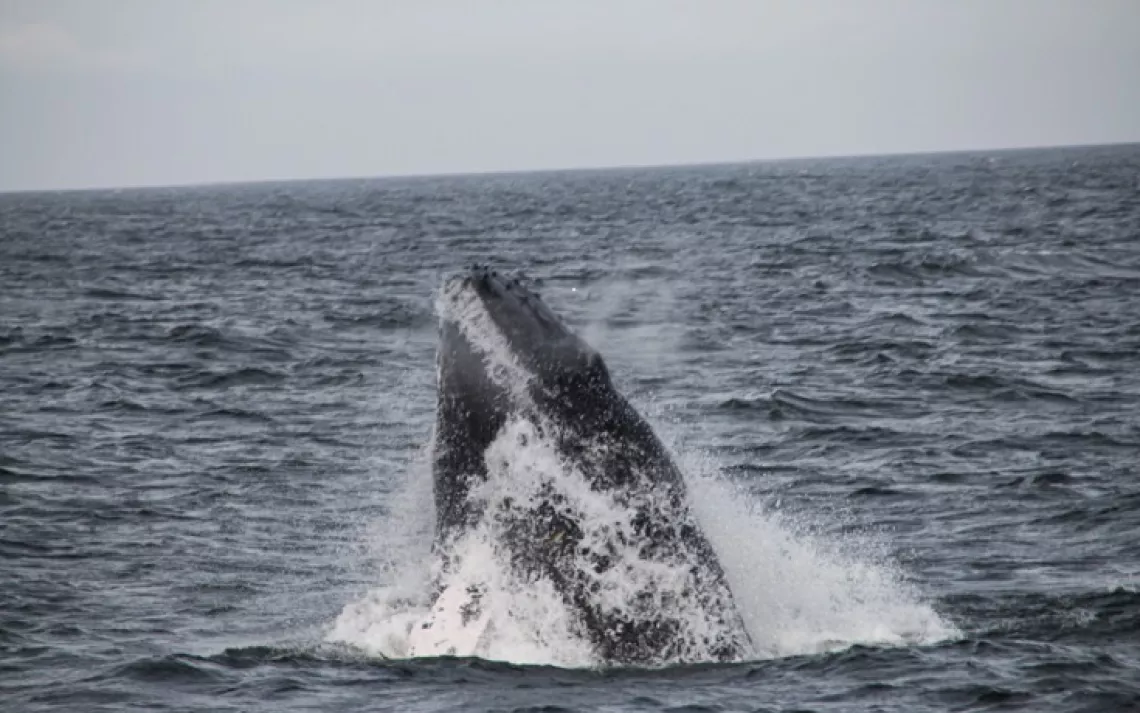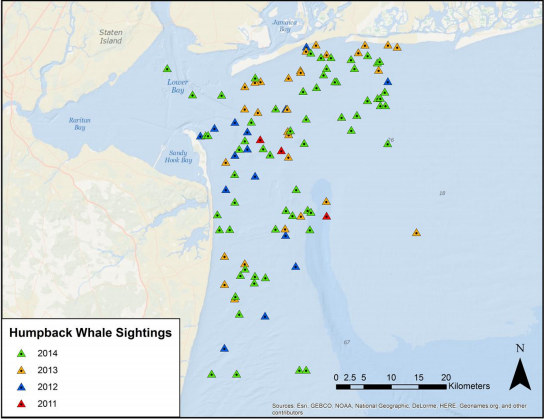Whales of New York
Sightings of humpback whales in New York Harbor have increased tenfold over the last five years

Whale breeching in New York Harbor | Photo by Ted Conbeer
Paul Sieswerda used to jokingly call the whale-watching tours he led in New York Harbor “whale-watching adventure cruises”—the real adventure was whether any whales would be spotted at all. But in recent years, that has changed. Sightings of humpback whales (Megaptera novaeangliae) in New York City have increased tenfold over the last five years. Sieswerda, who eschewed retirement to create the nonprofit whale-watching advocacy group Gotham Whale in 2011, chalks up their resurgence to a combination of factors, including cleaner waters and growing fish populations. He knows exactly when the whales arrived.
“The whales returned around 2010 and have been increasing ever since. Prior to that you only heard about very rare sightings,” says Sieswerda, who before founding Gotham Whale was the curator of the New York Aquarium for over 20 years. “If a whale had been seen, we would have heard about it.”
“In 2011, there was a total of three sightings,” Sieswerda says. The next year sightings doubled, then in 2013 doubled again. “In 2014, we saw as many whales as we had seen in all the three previous years combined.” By way of the whales’ unique, fingerprint-like flukes, Sieswerda and his team have been able to identify around 45 individual whales, which at least in total tonnage, is a lot of whale.
The Gotham Whale tours go out three days a week from Riis Landing in Rockaway, Queens between May and November, when the whales are visiting New York. The organization doesn’t own its own research vessel and instead travels on the American Princess, a boat otherwise used as a beach ferry. Sieswerda, who is seventy-four years old and has a thick Boston accent, serves as the naturalist on board, handing out floppy specimens of whale baleen and other educational props for the guests to examine. Once the boat is out on the water, however, he joins the guests in scoping out the horizon, hoping for humpbacks.
Most days the whales can be found in the waters of the western New York Bight, which is essentially the mouth of the Hudson River up to the Verrazano Narrows. The Hudson River’s cleanup—which began with a 1977 EPA ruling banning polluters like General Electric from discharging harmful PCBs into the river—has had a lot to do with the emergence of the whales and other marine species.

Courtesy of National Oceanic and Atmospheric Administration
According to Sieswerda, the whales also come to New York for the same reason people do: the food. Specifically, these humpback whales love menhaden fish, whose numbers have swelled in the past few years. Menhaden won’t be found on many menus, but the species is still fished on an industrial scale, most notably by Omega Protein (NYSE: OME) of Houston, which processes the fish into fertilizer and Omega-3 ‘fish oil’ supplements. In 2012, the Atlantic States Marine Fisheries Commission enacted a measure reducing the total allowable catch of menhaden by about 20 percent. This led to more menhaden, Sieswerda says, which in turn led to more humpback whales.
Sieswerda suggests that the whales could even be telling one another about the new local food scene. “They’re well-known to make noise and communicate to one another,” he says. “One of those sounds could be: ‘Wow, I just had a great meal here in New York!’” Research detailed in The Cultural Lives of Whales and Dolphins by Hal Whitehead and Luke Rendell supports the hypothesis that whales share information, such as where food can be found.
The whales may be telling each other about the harbor, but the same cannot be said for the humans of New York, who, to Sieswerda’s amazement, haven’t flocked out to sea with him to view these majestic marine mammals.
“We get all these Europeans,” he says. “They come to New York and want to see the wildlife. They are willing to make the trek from their hotels in Manhattan. But the people who live in New York City seem to be overwhelmed by the idea of traveling all the way to Rockaway.”
For the adventurous New Yorker, though, whales can be seen just off the city’s shoreline. The whales seem to love it there—they love the food and they’re telling all their friends about it. Hopefully more New Yorkers will do the same.
Watch a video from one of Paul Sieswerda's whale-watching tours:
 The Magazine of The Sierra Club
The Magazine of The Sierra Club



